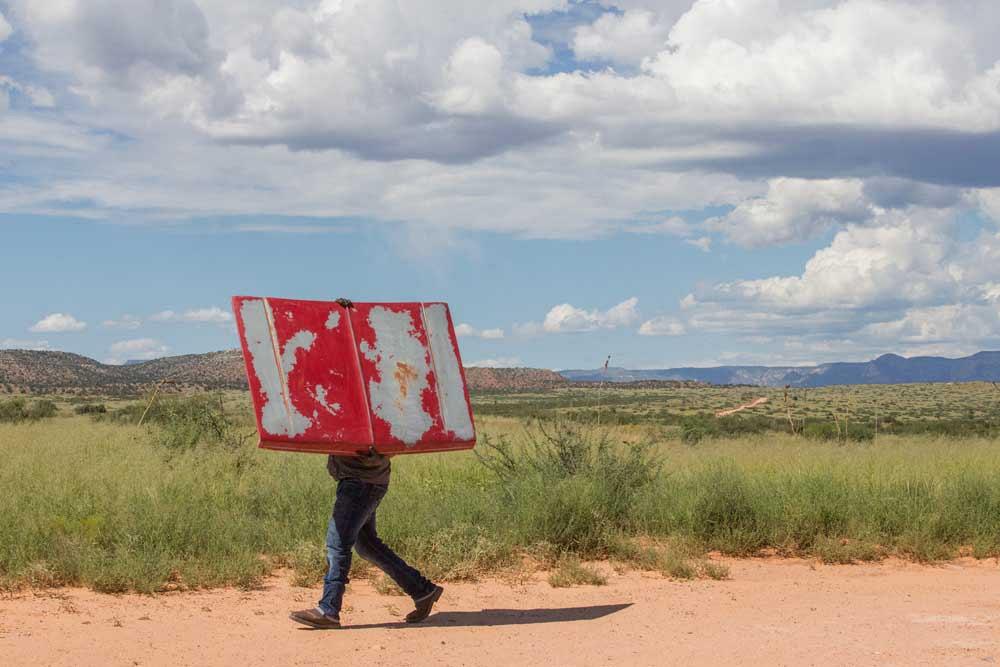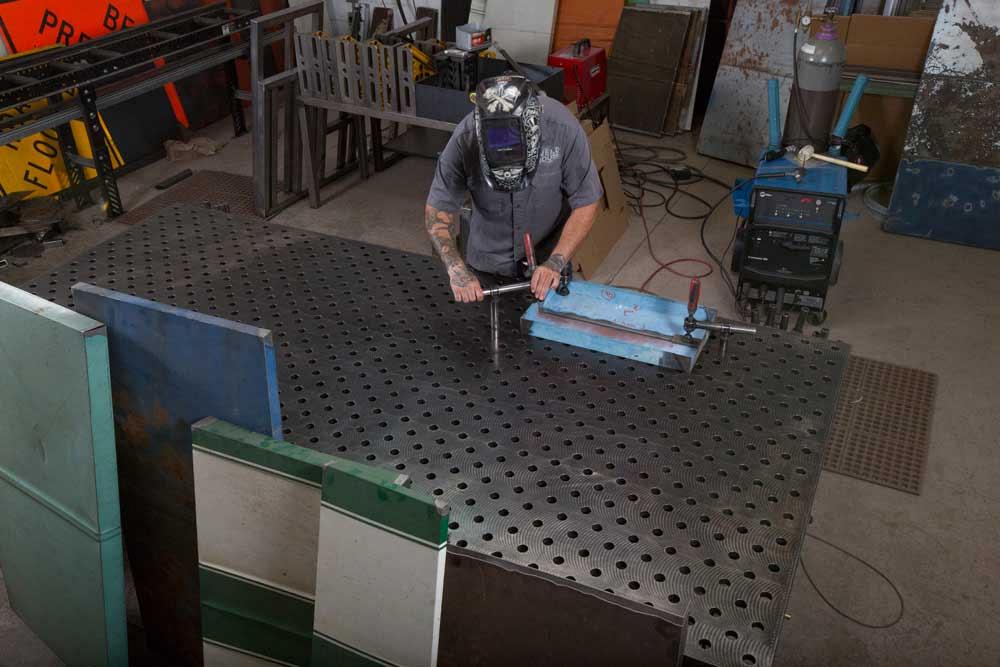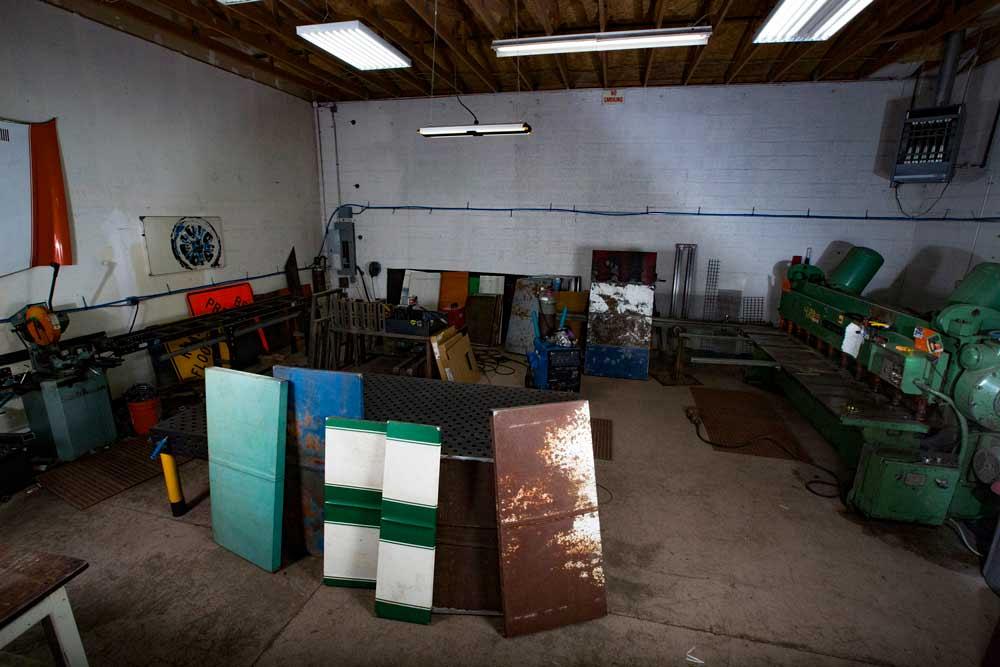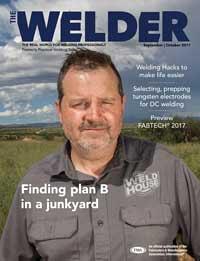- FMA
- The Fabricator
- FABTECH
- Canadian Metalworking
Categories
- Additive Manufacturing
- Aluminum Welding
- Arc Welding
- Assembly and Joining
- Automation and Robotics
- Bending and Forming
- Consumables
- Cutting and Weld Prep
- Electric Vehicles
- En Español
- Finishing
- Hydroforming
- Laser Cutting
- Laser Welding
- Machining
- Manufacturing Software
- Materials Handling
- Metals/Materials
- Oxyfuel Cutting
- Plasma Cutting
- Power Tools
- Punching and Other Holemaking
- Roll Forming
- Safety
- Sawing
- Shearing
- Shop Management
- Testing and Measuring
- Tube and Pipe Fabrication
- Tube and Pipe Production
- Waterjet Cutting
Industry Directory
Webcasts
Podcasts
FAB 40
Advertise
Subscribe
Account Login
Search
Fabricating a plan B
Joel Hester of Weld House risked everything to live and work on his own terms
- By Amanda Carlson
- September 21, 2017
- Article
- Arc Welding

Raiding the junkyard for that first coffee table was Hester’s lightbulb moment. Automotive metal is durable, readily available (as long as you know where to look), and has the weathered appearance that doesn’t require much effort on his part to perfect. Photos courtesy of Tommy Koppinger, Mesa, Ariz.
Starting over is a part of life, and no one knows that better than Joel Hester. The Texas native left a 15-year printing career to become a self-employed custom metal furniture builder.
While some people fear change, Hester has pretty much rolled with it and let optimism prevail. Even though he’s taken chances and is happier now than he would have been had he remained idle, he is by no means in a Pollyanna state. He is recently divorced and learning the difficulties of balancing work and life, especially now that a major contract has ended.
This isn’t a rags-to-riches story. This isn’t about a guy who made money hand over fist with a cool idea. This is the story about a guy who was brave enough to jump head-first into an endeavor without any guarantees of success. He’s made tough decisions and learned quickly how difficult it is to run a sustainable, niche-based small business.
Through it all Hester still has hope, propelled by a level-headed perspective and an inherent desire to succeed.
It All Started With a Bed Frame
Hester has always been creative and good with his hands. He learned to weld while working at a dairy in high school but ultimately followed in the footsteps of his grandfather and father and entered the printing world. He spent the first 10 years in sales but was sidelined for several months because of a bike accident.
“You build sales from the ground up, and I didn’t want to go back to square one. So I got into graphic design, but I had never run a Mac before.”
What he didn’t know he was determined to learn along the way. It’s a quality that would come in handy in later years.
As hardworking and talented as he was in the printing business, he was equally a natural working with his hands, particularly with metal. He enjoyed tinkering and even had made himself a bed frame out of necessity years before. Once he didn’t need it anymore, he put the bed up for sale on craigslist. Lo and behold, someone bought it.
He continued building bed frames for a while until one of his customers asked him to build a coffee table as well. It was an intriguing request, so Hester complied. There was one catch—the customer wanted the table to incorporate a beer sign they had collected.
“This beer sign threw me for a loop because it was superthin. I’m not even sure it was real metal. What was holding me up was how to weld thick to thin, especially given the welding skills I had at the time. I needed however much money I was going to make from delivering this project, but I was stuck and had to figure it out,” Hester said.

He may have ended up here thanks to a series of random decisions, but Joel Hester has found a way to run a successful small business by filling a niche. It hasn’t been easy, but nothing worthwhile ever is. Throughout the stress of small-business life, he’s doing something that makes him happy.
Without a clear solution in place, Hester felt a lot of pressure to do it right. He didn’t want to simply slap this sign onto a table haphazardly, nor did he want it to have sharp edges.
“I could have just tack welded it down, but my inner design voice just wouldn’t let me do it.”
He was stuck and out of ideas until it occurred to him to try a junkyard. Even now, more than 10 years later, he doesn’t know why he came to that conclusion, but that decision became the defining moment that led him to where he is today.
“I never went to junkyards growing up and I never worked on cars. I had Hondas growing up and those things never break. So, I don’t know why I did it, but I went to a junkyard. Toward the back of the yard was this huge boat of a car—a Cadillac—it was huge and it had really cool old paint.
“It turned into the craziest lightbulb moment where I could see the solution to my problem with the table. I didn’t know what I was looking for until I saw it. Honestly, it was a perfect storm of a customer who really wanted something and forcing me to stick with it long enough to where I was raw and open to just figuring out the solution to this problem. Having that lightbulb moment was like removing the spring off my neck.”
His concept, skinning the sheet metal off the old car and using that as the tabletop, led to more tables fabricated from old automotive metal hoods. The variety of colors paired with the weathered appearance made for beautiful, edgy, and unique pieces of furniture art.
He made a small website to market his abilities. He set up a small shop with a saw, a grinder, and a power source in his garage at his apartment complex in White Rock Lake, Texas. He posted photos of his work on his website and hit the jackpot when a major design blog shared a photo of one of his tables with its followers.
“I had the simplest, most archaic website, and I was so proud of the little clicker that told you how many visitors you had. When the blog picked up the coffee table, I went from 147 to 4,500 page views. Then other blogs picked up the content and it just ping-ponged around the internet. I was getting phone calls from people all around the country.”
To keep up with orders, Hester would go home on his lunch break and work in his garage.
“My saw was super shitty and it made all sorts of noise and sparks. So, I’d come home for lunch every day and make my cuts so that I wouldn’t have to make all that noise at night when my neighbors were home. I’d grind and weld in the evenings, and that’s just what I did,” Hester explained.

Automotive hoods Hester has collected sit outside of Weld House, which is located on the outskirts of scenic Sedona, Ariz.
Turning a Side Gig Into a Full-Time Career
More design blogs picked up Hester’s work, which meant more orders were coming in. Thanks to his boss at the printing company, Hester was able to move his fabricating operations to one of his properties, a space the size of a two-car garage.
While his fabricating business was on the upswing, print was on the decline. The internet had dawned and online media was quickly surpassing print. He was dating a woman and they were planning their future together, but he needed to decide if he should stay put and hope he could provide for a family with a career in printing, or if he should get out now and go into business for himself.
He chose himself.
In 2010, with a wife and child in tow as well as another child on the way, Hester left Texas and headed west to Arizona, where they settled down and eventually opened Weld House.
“I don’t know what I was thinking moving out here. Neither of us had jobs, and I’ve never had a shit ton of money as a fallback. Part of it was just wanting a change of scenery and not wanting to raise our kids in Texas. We wanted to be somewhere we could be outdoors and that had a culture of being outdoor-oriented.”
Hester’s first big client was clothing company Robert Graham. It started with one order, then two, and from there it snowballed. The company had plans to open more brick-and-mortar stores and contacted Hester to fabricate a set of display tables for each location.
“They were ordering four or five sets at a time, and each set was three tables. They wanted only blue and red tables; I was running all over the state just to find blue and red material. I could make their large table from only one type of truck.”
The account proved to be a huge learning experience for him. He had to learn how to juggle the demands of the Robert Graham contract while also finding time to address the onesie-twosie orders he was getting from customers via the website. His welding skills improved. For example, through trial and error he learned how to sequence his welds properly to avoid warpage. He was able to purchase a shear as well as a clear-coat gun and performed his own clear coating in-house.
“I got pretty good at identifying what was original paint and what had been painted several times, and those hoods make for some really cool tops. Even though they were all blue and red, there was still a lot going on.”
From Highs to Lows
Hester has experienced the highs, lows, and harsh realities of owning and operating a small business. One of those harsh realities was when Robert Graham ended its account with Hester. At the time, Hester was also on the cusp of landing another large account, but after some waiting it never came through.
“I got to the point in January of this year where I said I couldn’t wait on these people. I’m going to frickin’ die if I keep waiting on these people.”
Hester is doing his best to market his work through Instagram, through photos and a blog on his website, and through sponsored content on Facebook. His activity on social media, while important for an internet-based business such as his, has also opened up the reality of how many one-man custom metal furniture makers are out there and how important it is to differentiate himself from them.
He’s done some serious soul-searching over the last 10 months to figure out what kind of business he wants his to be, who he needs to be in front of, and what he needs to be able to do to be sustainable.
“I’m in the middle of a lifetime’s journey. I don’t have it all figured out. I don’t know where I’m going, but through my own widgets I’m assembling equipment that is relevant to building things for real companies.”
The individual custom work has steadily continued, and Hester can do more than just furniture. He’s still pursuing a few potentially large accounts, but those take time to develop and negotiate. While he’s not where he wants to be, in work or in life, he’s still able to look back and appreciate how far he’s come.
“I am the poster child for trying something new without having any beneficial prerequisite experience to suggest that was a good idea. I had no idea what I was doing while welding in my apartment. I had no internet, a $900 110-V welder, a $59 corded grinder, a $59 corded drill, and a $79 chop saw. I also had no pressure or overhead. I was just making stuff up as I went.
“My whole story began as a series of random decisions and circumstances that led to that lightbulb moment in the junkyard. The life lessons I learned in my previous career have helped me throughout the years, but I did not start my metal career with schooling and a crystal-clear business plan. My next 10 years really need to be purposeful and planned out,” Hester explained.
“My story isn’t rags to riches. I have not arrived at a good spot in life or work. I am in the middle of the battle. Loving what I do makes my life a lot easier to live every day, and making things that bring others a lot of joy is very rewarding.”
Weld House, 602-317-8499, www.weldhouse.com
About the Author

Amanda Carlson
2135 Point Blvd
Elgin, IL 60123
815-227-8260
Amanda Carlson was named as the editor for The WELDER in January 2017. She is responsible for coordinating and writing or editing all of the magazine’s editorial content. Before joining The WELDER, Amanda was a news editor for two years, coordinating and editing all product and industry news items for several publications and thefabricator.com.
About the Publication
subscribe now

The Welder, formerly known as Practical Welding Today, is a showcase of the real people who make the products we use and work with every day. This magazine has served the welding community in North America well for more than 20 years.
start your free subscription- Stay connected from anywhere

Easily access valuable industry resources now with full access to the digital edition of The Fabricator.

Easily access valuable industry resources now with full access to the digital edition of The Welder.

Easily access valuable industry resources now with full access to the digital edition of The Tube and Pipe Journal.
- Podcasting
- Podcast:
- The Fabricator Podcast
- Published:
- 04/16/2024
- Running Time:
- 63:29
In this episode of The Fabricator Podcast, Caleb Chamberlain, co-founder and CEO of OSH Cut, discusses his company’s...
- Trending Articles
Sheffield Forgemasters makes global leap in welding technology

ESAB unveils Texas facility renovation

Engine-driven welding machines include integrated air compressors

How welders can stay safe during grinding

The impact of sine and square waves in aluminum AC welding, Part I

- Industry Events
16th Annual Safety Conference
- April 30 - May 1, 2024
- Elgin,
Pipe and Tube Conference
- May 21 - 22, 2024
- Omaha, NE
World-Class Roll Forming Workshop
- June 5 - 6, 2024
- Louisville, KY
Advanced Laser Application Workshop
- June 25 - 27, 2024
- Novi, MI




























